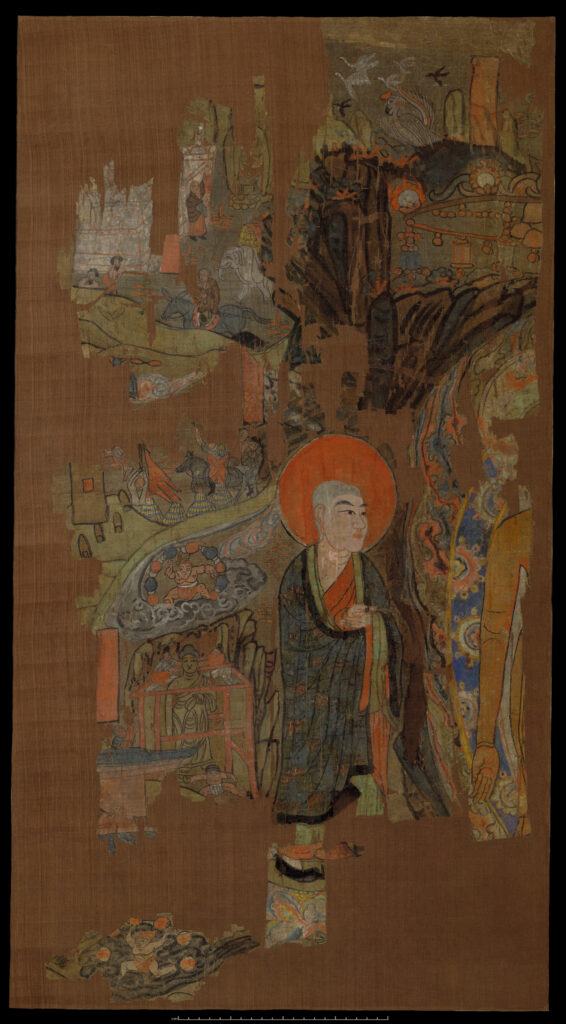Transmission of Buddhism
Transmission of Indian Buddhism
The first Sangha
Sakyamuni preaching on Vulture Peak
This fragment of an eighth to ninth century silk painting depicts Sakyamuni, the historical Buddha, preaching to disciples at Vulture Peak.
On the right edge of the fragment is the downward pointing arm of the Buddha, rendered in gold and surrounded by an elaborate mandala. This image of the Buddha would have been the centre of the image, attended by monks on either side, one of which is prominent in this fragment. Behind the Buddha are dark rocks, and a vulture perching on the mountain peak, signifying Vulture Peak.
Vulture Peak is a mountain in the historical town of Rajagaha (now Rajgir) in Nalanda, India. It is known to be the Buddha’s favourite retreat, where he would deliver his sermons to the Sangha.
The Buddha gave his first teachings to five fellow ascetic men. After awakening themselves, these disciples of the Buddha formed the first Sangha. This was the first monastic community of Buddhist monks. The Buddha and the Sangha travelled from place to place sharing the teachings of the Dharma and attracting new Buddhist followers throughout Northern India. Some would renounce their lives and join the Sangha, which grew into a large practicing community. Others who wished to continue their worldly lives (laypeople) could receive teachings and guidance from the Sangha whilst supporting them in return. By providing them with food, clothes and shelter, laypeople could accumulate good karma. After a few years, women were also allowed to join the Sangha as nuns. The Buddha and the Sangha continued this work until the Buddha’s death (or parinirvana) at age 80.
Following the Buddha’s death, it is believed that the Sangha held several councils to determine how they continue spreading Buddha’s teachings. Alongside setting rules for the Sangha, these councils ordered the Buddha’s oral teachings into a collection of scriptures called sutras. The Sangha grew, and at the same time, gradually split into several different schools. Buddhism remained in Northern India until the 3rd century BCE, when it was sponsored by King Ashoka of the Mauryan empire.
Introduction into Central Asia

The first step in the spread of Buddhism into Central Asia was the missionary activity brought about by King Ashoka in the 3rd century BCE. Ashoka (268-232 BCE) was the ruler of the Mauryan Empire, which in his time came to include most of the Indian subcontinent. Ashoka converted to Buddhism, and became its most powerful patron, establishing monasteries and stupas (Buddhist monuments) across the country. His Buddhist outlook was also etched into pillars and stones at pilgrimage sites, written in local dialects so that all could read his message. As well as strengthening the monasteries within his kingdom, Ashoka sent missionaries to countries further afield in Central Asia.
Evolution of Buddhism in India
Buddhism flourished and developed in India for most of the 1st millennium CE, enriched by the arrival of the Mahayana and then the Vajrayana. But around the turn of the millennium, Buddhism’s influence diminished over the course of several centuries. Royal support of Buddhism waned, whilst a Hindu renaissance emerged in the south, gradually becoming India’s dominant religion. Invasions by the Huns and Turkic peoples from the north resulted in the destruction of Buddhist institutions. One of the final blows was the University of Nalanda, which fell at the end of the 12th century. By this point however, Buddhism was well established in Central, East and Southeast Asia.
